ACR 212 - Policy Report: Analysis of Surveillance Technology Impacts
VerifiedAdded on 2023/04/10
|11
|2160
|92
Report
AI Summary
This technology report examines the use, effectiveness, and impacts of surveillance technology, specifically focusing on Closed Circuit Television (CCTV). The report delves into the constitutional and informational privacy aspects, exploring the ethical motives for guarding personal information and the evolution of technology in relation to privacy. It highlights the potential for misuse of personal data, the impact of surveillance on individual behavior and self-identity, and the importance of balancing security with individual rights. The report provides an overview of CCTV, discussing its applications in law enforcement and workplaces, and its implications for privacy. The report also discusses privacy-enhancing technologies and concludes with recommendations for government action, emphasizing the need for strategic planning and the integration of CCTV as a tool within a broader framework to address local problems effectively.
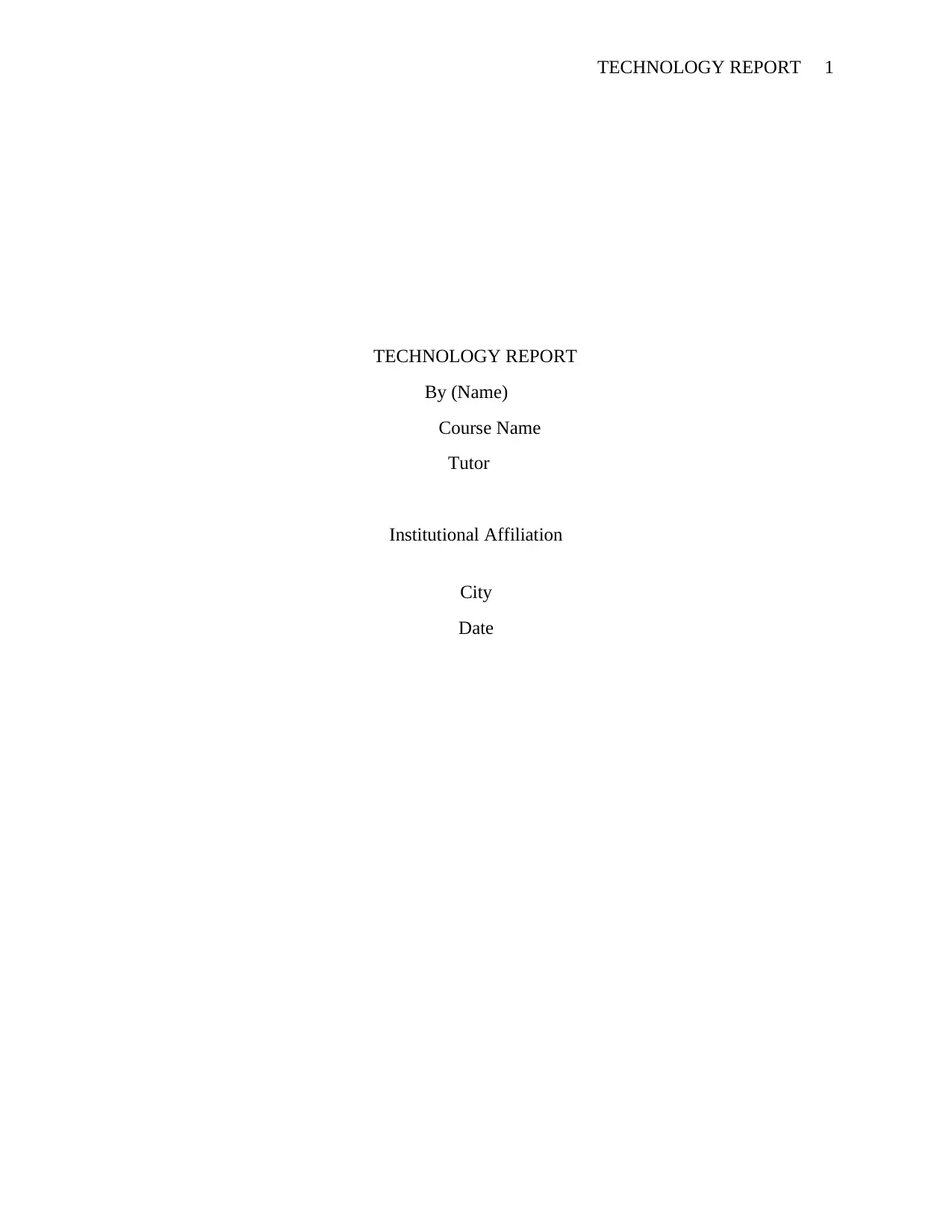
TECHNOLOGY REPORT 1
TECHNOLOGY REPORT
By (Name)
Course Name
Tutor
Institutional Affiliation
City
Date
TECHNOLOGY REPORT
By (Name)
Course Name
Tutor
Institutional Affiliation
City
Date
Paraphrase This Document
Need a fresh take? Get an instant paraphrase of this document with our AI Paraphraser
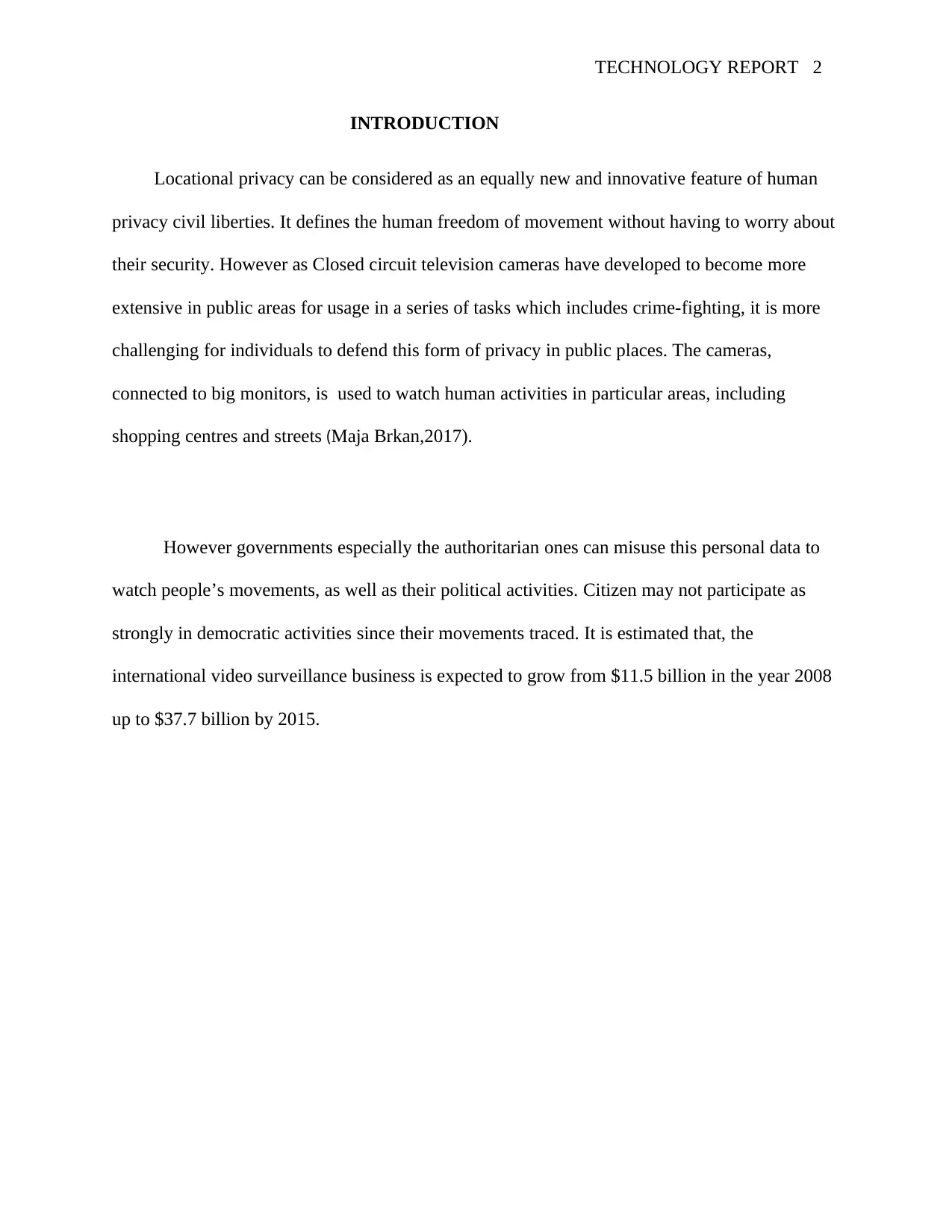
TECHNOLOGY REPORT 2
INTRODUCTION
Locational privacy can be considered as an equally new and innovative feature of human
privacy civil liberties. It defines the human freedom of movement without having to worry about
their security. However as Closed circuit television cameras have developed to become more
extensive in public areas for usage in a series of tasks which includes crime-fighting, it is more
challenging for individuals to defend this form of privacy in public places. The cameras,
connected to big monitors, is used to watch human activities in particular areas, including
shopping centres and streets (Maja Brkan,2017).
However governments especially the authoritarian ones can misuse this personal data to
watch people’s movements, as well as their political activities. Citizen may not participate as
strongly in democratic activities since their movements traced. It is estimated that, the
international video surveillance business is expected to grow from $11.5 billion in the year 2008
up to $37.7 billion by 2015.
INTRODUCTION
Locational privacy can be considered as an equally new and innovative feature of human
privacy civil liberties. It defines the human freedom of movement without having to worry about
their security. However as Closed circuit television cameras have developed to become more
extensive in public areas for usage in a series of tasks which includes crime-fighting, it is more
challenging for individuals to defend this form of privacy in public places. The cameras,
connected to big monitors, is used to watch human activities in particular areas, including
shopping centres and streets (Maja Brkan,2017).
However governments especially the authoritarian ones can misuse this personal data to
watch people’s movements, as well as their political activities. Citizen may not participate as
strongly in democratic activities since their movements traced. It is estimated that, the
international video surveillance business is expected to grow from $11.5 billion in the year 2008
up to $37.7 billion by 2015.
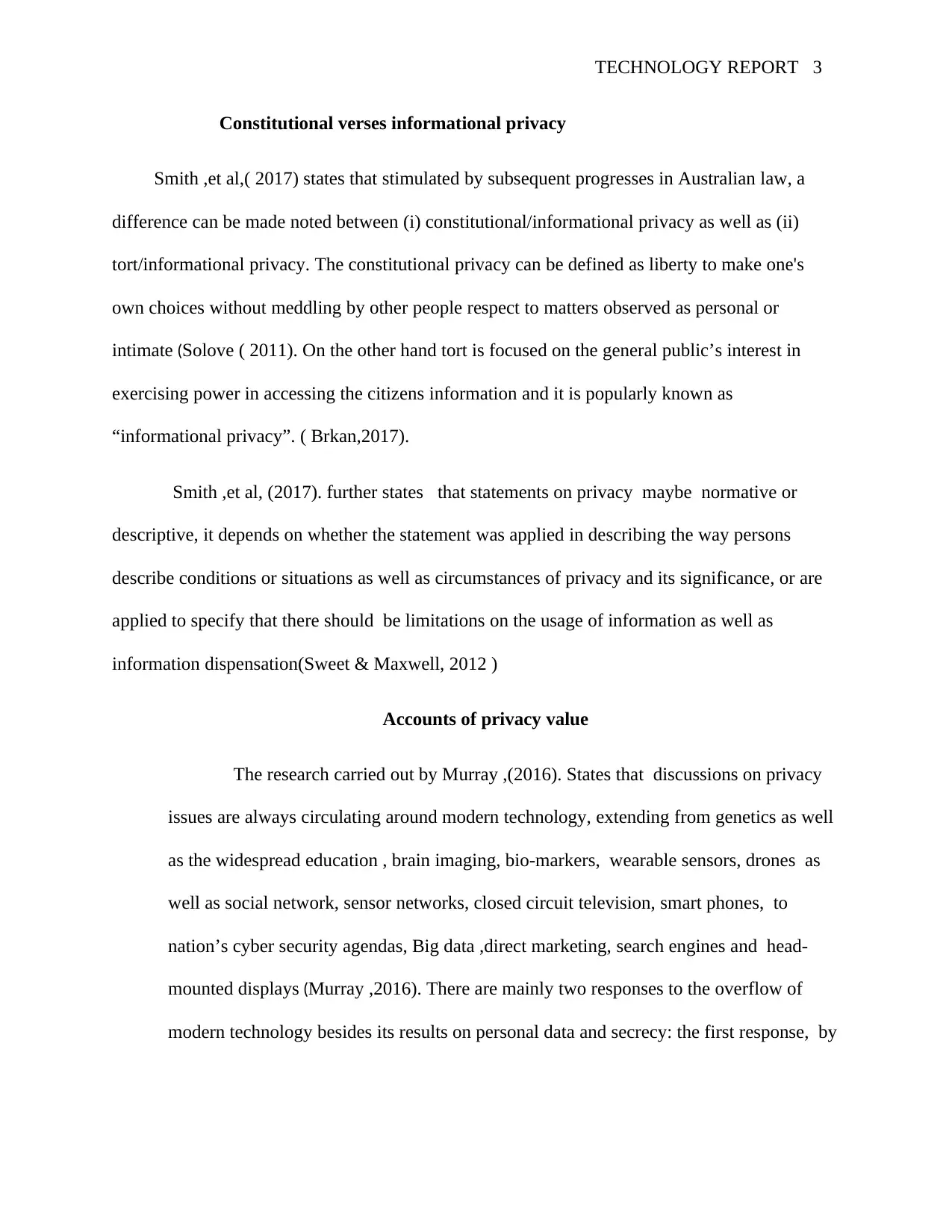
TECHNOLOGY REPORT 3
Constitutional verses informational privacy
Smith ,et al,( 2017) states that stimulated by subsequent progresses in Australian law, a
difference can be made noted between (i) constitutional/informational privacy as well as (ii)
tort/informational privacy. The constitutional privacy can be defined as liberty to make one's
own choices without meddling by other people respect to matters observed as personal or
intimate (Solove ( 2011). On the other hand tort is focused on the general public’s interest in
exercising power in accessing the citizens information and it is popularly known as
“informational privacy”. ( Brkan,2017).
Smith ,et al, (2017). further states that statements on privacy maybe normative or
descriptive, it depends on whether the statement was applied in describing the way persons
describe conditions or situations as well as circumstances of privacy and its significance, or are
applied to specify that there should be limitations on the usage of information as well as
information dispensation(Sweet & Maxwell, 2012 )
Accounts of privacy value
The research carried out by Murray ,(2016). States that discussions on privacy
issues are always circulating around modern technology, extending from genetics as well
as the widespread education , brain imaging, bio-markers, wearable sensors, drones as
well as social network, sensor networks, closed circuit television, smart phones, to
nation’s cyber security agendas, Big data ,direct marketing, search engines and head-
mounted displays (Murray ,2016). There are mainly two responses to the overflow of
modern technology besides its results on personal data and secrecy: the first response, by
Constitutional verses informational privacy
Smith ,et al,( 2017) states that stimulated by subsequent progresses in Australian law, a
difference can be made noted between (i) constitutional/informational privacy as well as (ii)
tort/informational privacy. The constitutional privacy can be defined as liberty to make one's
own choices without meddling by other people respect to matters observed as personal or
intimate (Solove ( 2011). On the other hand tort is focused on the general public’s interest in
exercising power in accessing the citizens information and it is popularly known as
“informational privacy”. ( Brkan,2017).
Smith ,et al, (2017). further states that statements on privacy maybe normative or
descriptive, it depends on whether the statement was applied in describing the way persons
describe conditions or situations as well as circumstances of privacy and its significance, or are
applied to specify that there should be limitations on the usage of information as well as
information dispensation(Sweet & Maxwell, 2012 )
Accounts of privacy value
The research carried out by Murray ,(2016). States that discussions on privacy
issues are always circulating around modern technology, extending from genetics as well
as the widespread education , brain imaging, bio-markers, wearable sensors, drones as
well as social network, sensor networks, closed circuit television, smart phones, to
nation’s cyber security agendas, Big data ,direct marketing, search engines and head-
mounted displays (Murray ,2016). There are mainly two responses to the overflow of
modern technology besides its results on personal data and secrecy: the first response, by
⊘ This is a preview!⊘
Do you want full access?
Subscribe today to unlock all pages.

Trusted by 1+ million students worldwide
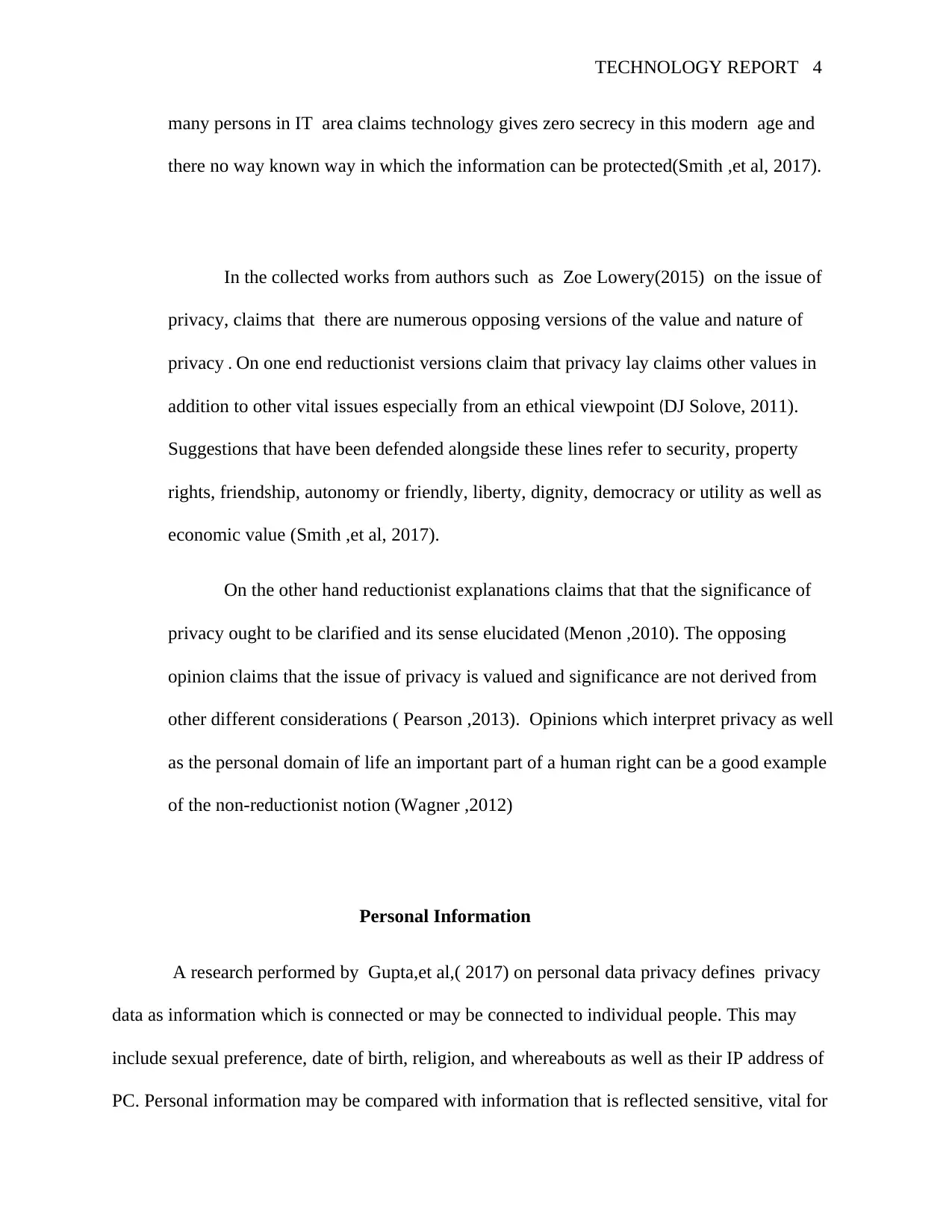
TECHNOLOGY REPORT 4
many persons in IT area claims technology gives zero secrecy in this modern age and
there no way known way in which the information can be protected(Smith ,et al, 2017).
In the collected works from authors such as Zoe Lowery(2015) on the issue of
privacy, claims that there are numerous opposing versions of the value and nature of
privacy . On one end reductionist versions claim that privacy lay claims other values in
addition to other vital issues especially from an ethical viewpoint (DJ Solove, 2011).
Suggestions that have been defended alongside these lines refer to security, property
rights, friendship, autonomy or friendly, liberty, dignity, democracy or utility as well as
economic value (Smith ,et al, 2017).
On the other hand reductionist explanations claims that that the significance of
privacy ought to be clarified and its sense elucidated (Menon ,2010). The opposing
opinion claims that the issue of privacy is valued and significance are not derived from
other different considerations ( Pearson ,2013). Opinions which interpret privacy as well
as the personal domain of life an important part of a human right can be a good example
of the non-reductionist notion (Wagner ,2012)
Personal Information
A research performed by Gupta,et al,( 2017) on personal data privacy defines privacy
data as information which is connected or may be connected to individual people. This may
include sexual preference, date of birth, religion, and whereabouts as well as their IP address of
PC. Personal information may be compared with information that is reflected sensitive, vital for
many persons in IT area claims technology gives zero secrecy in this modern age and
there no way known way in which the information can be protected(Smith ,et al, 2017).
In the collected works from authors such as Zoe Lowery(2015) on the issue of
privacy, claims that there are numerous opposing versions of the value and nature of
privacy . On one end reductionist versions claim that privacy lay claims other values in
addition to other vital issues especially from an ethical viewpoint (DJ Solove, 2011).
Suggestions that have been defended alongside these lines refer to security, property
rights, friendship, autonomy or friendly, liberty, dignity, democracy or utility as well as
economic value (Smith ,et al, 2017).
On the other hand reductionist explanations claims that that the significance of
privacy ought to be clarified and its sense elucidated (Menon ,2010). The opposing
opinion claims that the issue of privacy is valued and significance are not derived from
other different considerations ( Pearson ,2013). Opinions which interpret privacy as well
as the personal domain of life an important part of a human right can be a good example
of the non-reductionist notion (Wagner ,2012)
Personal Information
A research performed by Gupta,et al,( 2017) on personal data privacy defines privacy
data as information which is connected or may be connected to individual people. This may
include sexual preference, date of birth, religion, and whereabouts as well as their IP address of
PC. Personal information may be compared with information that is reflected sensitive, vital for
Paraphrase This Document
Need a fresh take? Get an instant paraphrase of this document with our AI Paraphraser
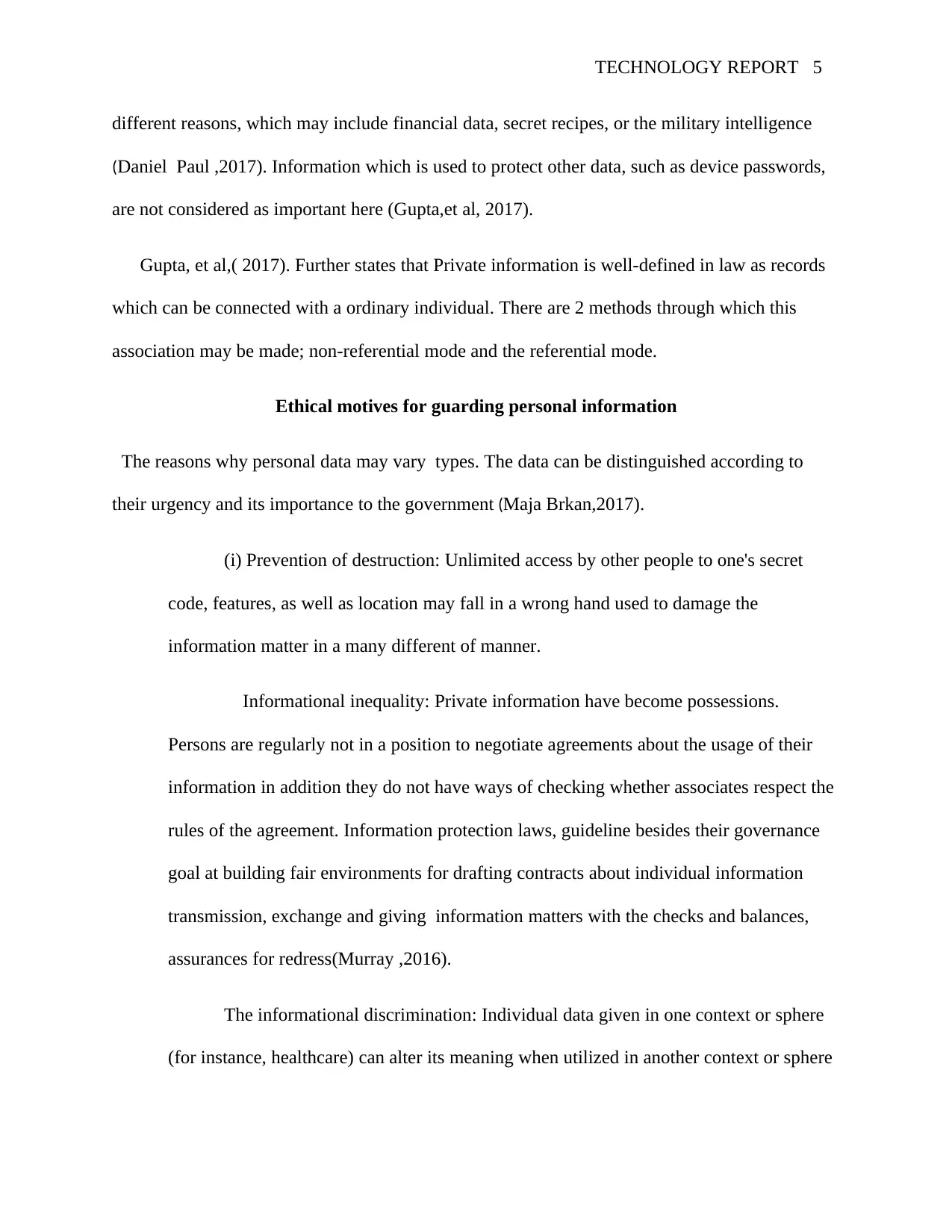
TECHNOLOGY REPORT 5
different reasons, which may include financial data, secret recipes, or the military intelligence
(Daniel Paul ,2017). Information which is used to protect other data, such as device passwords,
are not considered as important here (Gupta,et al, 2017).
Gupta, et al,( 2017). Further states that Private information is well-defined in law as records
which can be connected with a ordinary individual. There are 2 methods through which this
association may be made; non-referential mode and the referential mode.
Ethical motives for guarding personal information
The reasons why personal data may vary types. The data can be distinguished according to
their urgency and its importance to the government (Maja Brkan,2017).
(i) Prevention of destruction: Unlimited access by other people to one's secret
code, features, as well as location may fall in a wrong hand used to damage the
information matter in a many different of manner.
Informational inequality: Private information have become possessions.
Persons are regularly not in a position to negotiate agreements about the usage of their
information in addition they do not have ways of checking whether associates respect the
rules of the agreement. Information protection laws, guideline besides their governance
goal at building fair environments for drafting contracts about individual information
transmission, exchange and giving information matters with the checks and balances,
assurances for redress(Murray ,2016).
The informational discrimination: Individual data given in one context or sphere
(for instance, healthcare) can alter its meaning when utilized in another context or sphere
different reasons, which may include financial data, secret recipes, or the military intelligence
(Daniel Paul ,2017). Information which is used to protect other data, such as device passwords,
are not considered as important here (Gupta,et al, 2017).
Gupta, et al,( 2017). Further states that Private information is well-defined in law as records
which can be connected with a ordinary individual. There are 2 methods through which this
association may be made; non-referential mode and the referential mode.
Ethical motives for guarding personal information
The reasons why personal data may vary types. The data can be distinguished according to
their urgency and its importance to the government (Maja Brkan,2017).
(i) Prevention of destruction: Unlimited access by other people to one's secret
code, features, as well as location may fall in a wrong hand used to damage the
information matter in a many different of manner.
Informational inequality: Private information have become possessions.
Persons are regularly not in a position to negotiate agreements about the usage of their
information in addition they do not have ways of checking whether associates respect the
rules of the agreement. Information protection laws, guideline besides their governance
goal at building fair environments for drafting contracts about individual information
transmission, exchange and giving information matters with the checks and balances,
assurances for redress(Murray ,2016).
The informational discrimination: Individual data given in one context or sphere
(for instance, healthcare) can alter its meaning when utilized in another context or sphere
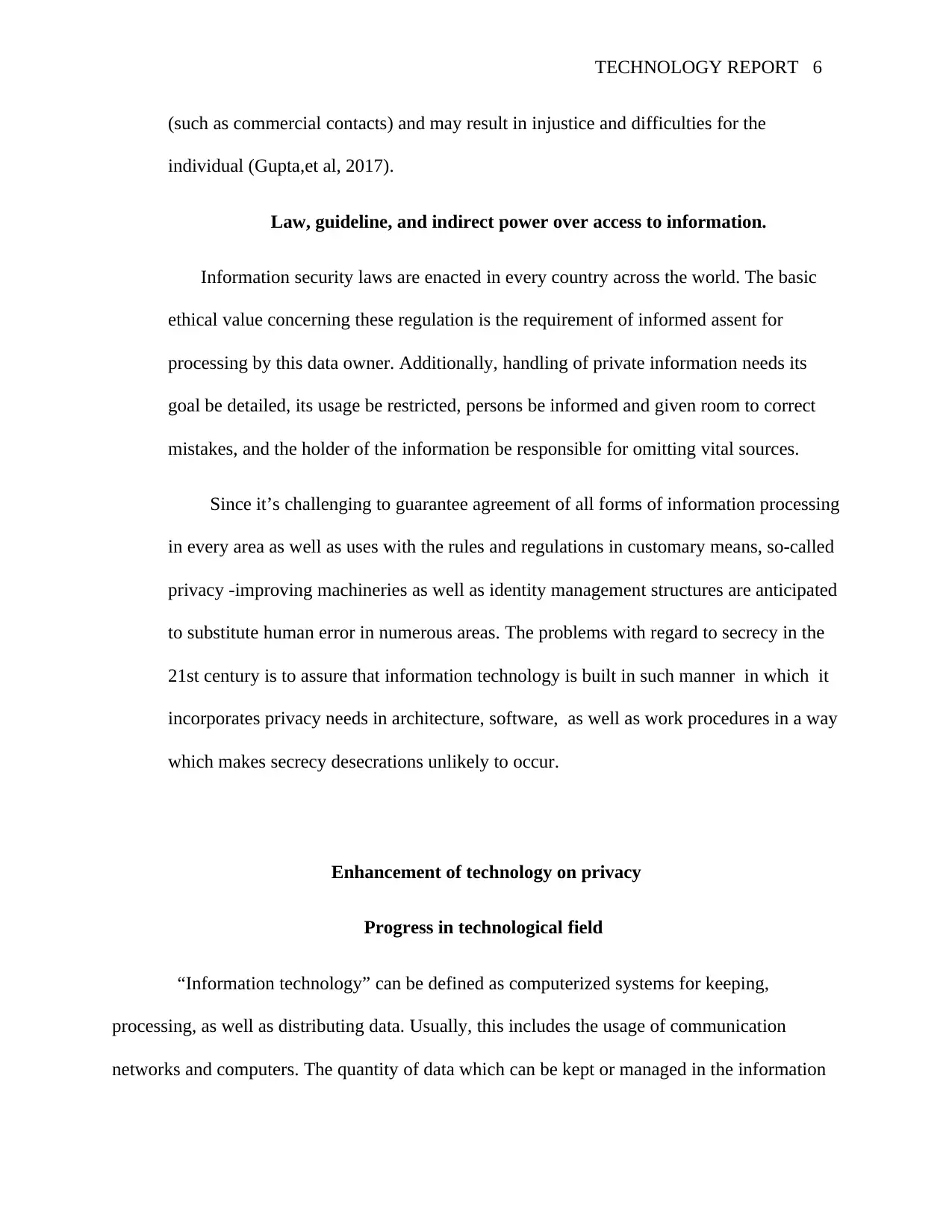
TECHNOLOGY REPORT 6
(such as commercial contacts) and may result in injustice and difficulties for the
individual (Gupta,et al, 2017).
Law, guideline, and indirect power over access to information.
Information security laws are enacted in every country across the world. The basic
ethical value concerning these regulation is the requirement of informed assent for
processing by this data owner. Additionally, handling of private information needs its
goal be detailed, its usage be restricted, persons be informed and given room to correct
mistakes, and the holder of the information be responsible for omitting vital sources.
Since it’s challenging to guarantee agreement of all forms of information processing
in every area as well as uses with the rules and regulations in customary means, so-called
privacy -improving machineries as well as identity management structures are anticipated
to substitute human error in numerous areas. The problems with regard to secrecy in the
21st century is to assure that information technology is built in such manner in which it
incorporates privacy needs in architecture, software, as well as work procedures in a way
which makes secrecy desecrations unlikely to occur.
Enhancement of technology on privacy
Progress in technological field
“Information technology” can be defined as computerized systems for keeping,
processing, as well as distributing data. Usually, this includes the usage of communication
networks and computers. The quantity of data which can be kept or managed in the information
(such as commercial contacts) and may result in injustice and difficulties for the
individual (Gupta,et al, 2017).
Law, guideline, and indirect power over access to information.
Information security laws are enacted in every country across the world. The basic
ethical value concerning these regulation is the requirement of informed assent for
processing by this data owner. Additionally, handling of private information needs its
goal be detailed, its usage be restricted, persons be informed and given room to correct
mistakes, and the holder of the information be responsible for omitting vital sources.
Since it’s challenging to guarantee agreement of all forms of information processing
in every area as well as uses with the rules and regulations in customary means, so-called
privacy -improving machineries as well as identity management structures are anticipated
to substitute human error in numerous areas. The problems with regard to secrecy in the
21st century is to assure that information technology is built in such manner in which it
incorporates privacy needs in architecture, software, as well as work procedures in a way
which makes secrecy desecrations unlikely to occur.
Enhancement of technology on privacy
Progress in technological field
“Information technology” can be defined as computerized systems for keeping,
processing, as well as distributing data. Usually, this includes the usage of communication
networks and computers. The quantity of data which can be kept or managed in the information
⊘ This is a preview!⊘
Do you want full access?
Subscribe today to unlock all pages.

Trusted by 1+ million students worldwide
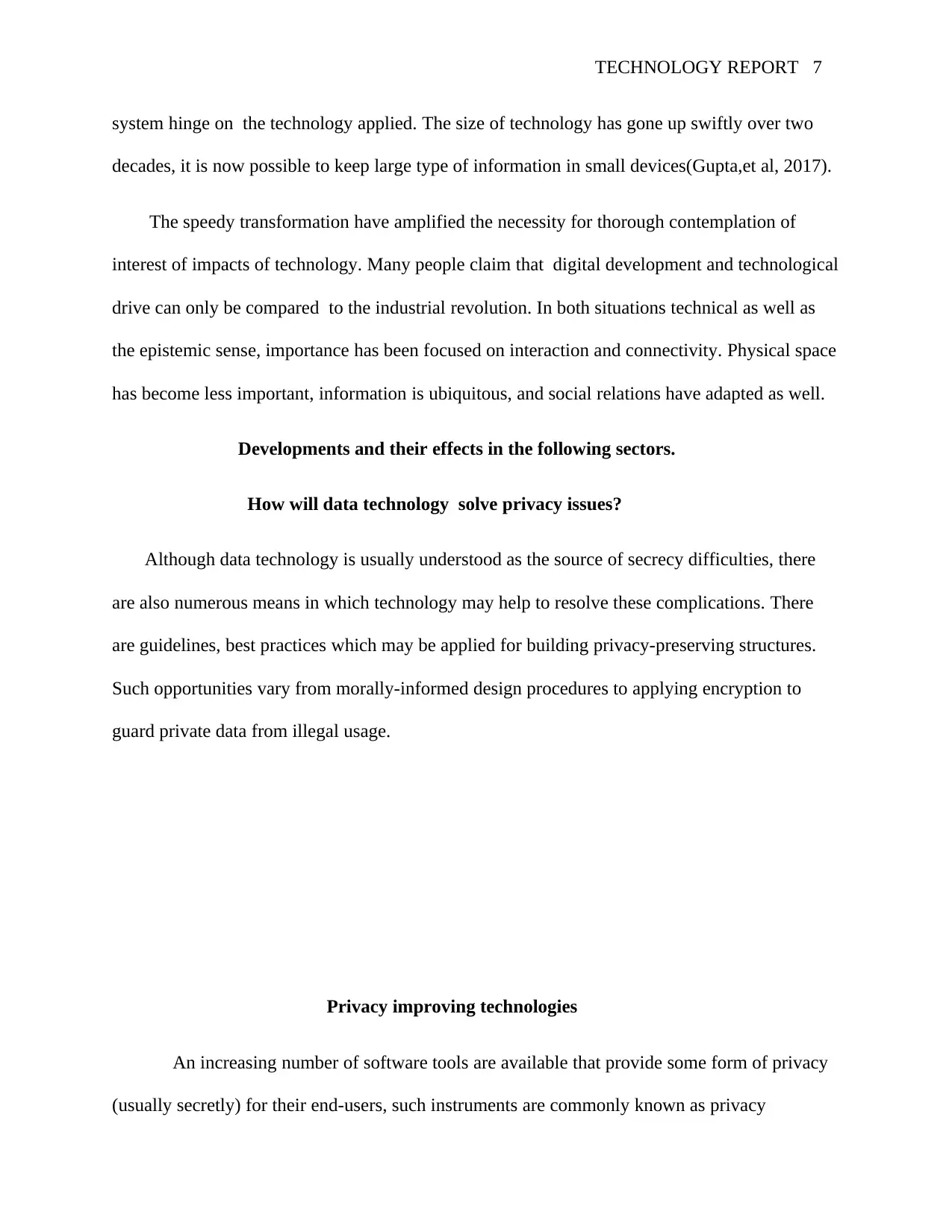
TECHNOLOGY REPORT 7
system hinge on the technology applied. The size of technology has gone up swiftly over two
decades, it is now possible to keep large type of information in small devices(Gupta,et al, 2017).
The speedy transformation have amplified the necessity for thorough contemplation of
interest of impacts of technology. Many people claim that digital development and technological
drive can only be compared to the industrial revolution. In both situations technical as well as
the epistemic sense, importance has been focused on interaction and connectivity. Physical space
has become less important, information is ubiquitous, and social relations have adapted as well.
Developments and their effects in the following sectors.
How will data technology solve privacy issues?
Although data technology is usually understood as the source of secrecy difficulties, there
are also numerous means in which technology may help to resolve these complications. There
are guidelines, best practices which may be applied for building privacy-preserving structures.
Such opportunities vary from morally-informed design procedures to applying encryption to
guard private data from illegal usage.
Privacy improving technologies
An increasing number of software tools are available that provide some form of privacy
(usually secretly) for their end-users, such instruments are commonly known as privacy
system hinge on the technology applied. The size of technology has gone up swiftly over two
decades, it is now possible to keep large type of information in small devices(Gupta,et al, 2017).
The speedy transformation have amplified the necessity for thorough contemplation of
interest of impacts of technology. Many people claim that digital development and technological
drive can only be compared to the industrial revolution. In both situations technical as well as
the epistemic sense, importance has been focused on interaction and connectivity. Physical space
has become less important, information is ubiquitous, and social relations have adapted as well.
Developments and their effects in the following sectors.
How will data technology solve privacy issues?
Although data technology is usually understood as the source of secrecy difficulties, there
are also numerous means in which technology may help to resolve these complications. There
are guidelines, best practices which may be applied for building privacy-preserving structures.
Such opportunities vary from morally-informed design procedures to applying encryption to
guard private data from illegal usage.
Privacy improving technologies
An increasing number of software tools are available that provide some form of privacy
(usually secretly) for their end-users, such instruments are commonly known as privacy
Paraphrase This Document
Need a fresh take? Get an instant paraphrase of this document with our AI Paraphraser
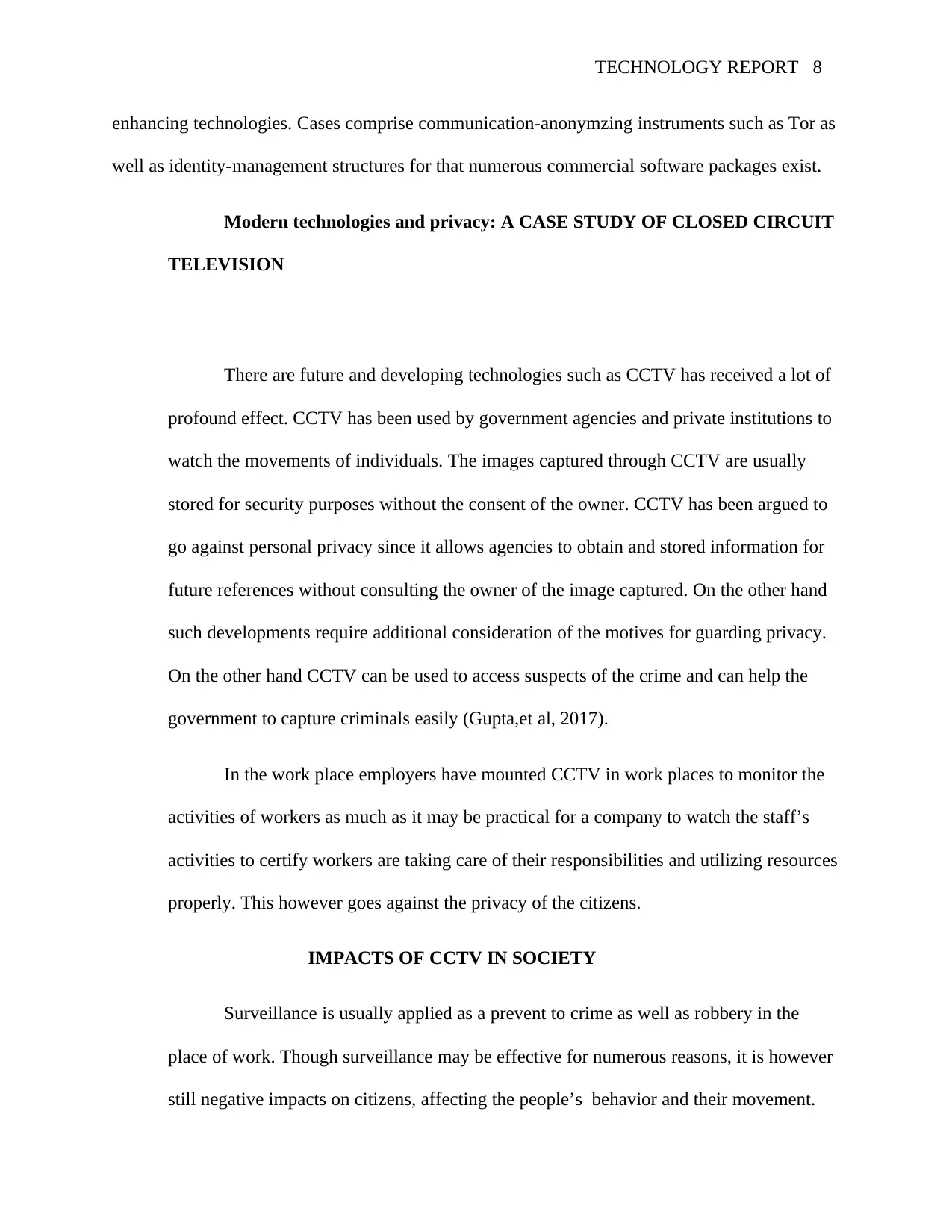
TECHNOLOGY REPORT 8
enhancing technologies. Cases comprise communication-anonymzing instruments such as Tor as
well as identity-management structures for that numerous commercial software packages exist.
Modern technologies and privacy: A CASE STUDY OF CLOSED CIRCUIT
TELEVISION
There are future and developing technologies such as CCTV has received a lot of
profound effect. CCTV has been used by government agencies and private institutions to
watch the movements of individuals. The images captured through CCTV are usually
stored for security purposes without the consent of the owner. CCTV has been argued to
go against personal privacy since it allows agencies to obtain and stored information for
future references without consulting the owner of the image captured. On the other hand
such developments require additional consideration of the motives for guarding privacy.
On the other hand CCTV can be used to access suspects of the crime and can help the
government to capture criminals easily (Gupta,et al, 2017).
In the work place employers have mounted CCTV in work places to monitor the
activities of workers as much as it may be practical for a company to watch the staff’s
activities to certify workers are taking care of their responsibilities and utilizing resources
properly. This however goes against the privacy of the citizens.
IMPACTS OF CCTV IN SOCIETY
Surveillance is usually applied as a prevent to crime as well as robbery in the
place of work. Though surveillance may be effective for numerous reasons, it is however
still negative impacts on citizens, affecting the people’s behavior and their movement.
enhancing technologies. Cases comprise communication-anonymzing instruments such as Tor as
well as identity-management structures for that numerous commercial software packages exist.
Modern technologies and privacy: A CASE STUDY OF CLOSED CIRCUIT
TELEVISION
There are future and developing technologies such as CCTV has received a lot of
profound effect. CCTV has been used by government agencies and private institutions to
watch the movements of individuals. The images captured through CCTV are usually
stored for security purposes without the consent of the owner. CCTV has been argued to
go against personal privacy since it allows agencies to obtain and stored information for
future references without consulting the owner of the image captured. On the other hand
such developments require additional consideration of the motives for guarding privacy.
On the other hand CCTV can be used to access suspects of the crime and can help the
government to capture criminals easily (Gupta,et al, 2017).
In the work place employers have mounted CCTV in work places to monitor the
activities of workers as much as it may be practical for a company to watch the staff’s
activities to certify workers are taking care of their responsibilities and utilizing resources
properly. This however goes against the privacy of the citizens.
IMPACTS OF CCTV IN SOCIETY
Surveillance is usually applied as a prevent to crime as well as robbery in the
place of work. Though surveillance may be effective for numerous reasons, it is however
still negative impacts on citizens, affecting the people’s behavior and their movement.
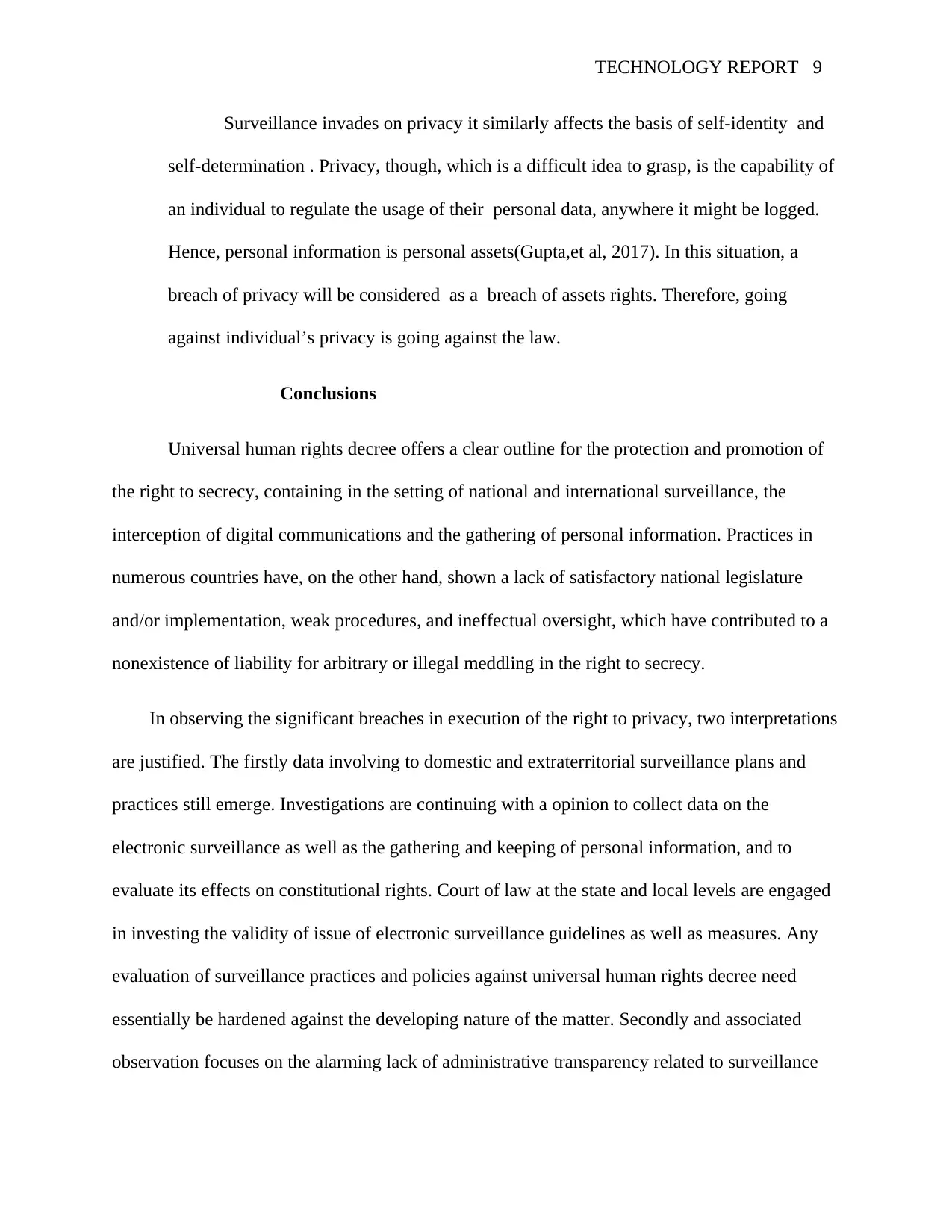
TECHNOLOGY REPORT 9
Surveillance invades on privacy it similarly affects the basis of self-identity and
self-determination . Privacy, though, which is a difficult idea to grasp, is the capability of
an individual to regulate the usage of their personal data, anywhere it might be logged.
Hence, personal information is personal assets(Gupta,et al, 2017). In this situation, a
breach of privacy will be considered as a breach of assets rights. Therefore, going
against individual’s privacy is going against the law.
Conclusions
Universal human rights decree offers a clear outline for the protection and promotion of
the right to secrecy, containing in the setting of national and international surveillance, the
interception of digital communications and the gathering of personal information. Practices in
numerous countries have, on the other hand, shown a lack of satisfactory national legislature
and/or implementation, weak procedures, and ineffectual oversight, which have contributed to a
nonexistence of liability for arbitrary or illegal meddling in the right to secrecy.
In observing the significant breaches in execution of the right to privacy, two interpretations
are justified. The firstly data involving to domestic and extraterritorial surveillance plans and
practices still emerge. Investigations are continuing with a opinion to collect data on the
electronic surveillance as well as the gathering and keeping of personal information, and to
evaluate its effects on constitutional rights. Court of law at the state and local levels are engaged
in investing the validity of issue of electronic surveillance guidelines as well as measures. Any
evaluation of surveillance practices and policies against universal human rights decree need
essentially be hardened against the developing nature of the matter. Secondly and associated
observation focuses on the alarming lack of administrative transparency related to surveillance
Surveillance invades on privacy it similarly affects the basis of self-identity and
self-determination . Privacy, though, which is a difficult idea to grasp, is the capability of
an individual to regulate the usage of their personal data, anywhere it might be logged.
Hence, personal information is personal assets(Gupta,et al, 2017). In this situation, a
breach of privacy will be considered as a breach of assets rights. Therefore, going
against individual’s privacy is going against the law.
Conclusions
Universal human rights decree offers a clear outline for the protection and promotion of
the right to secrecy, containing in the setting of national and international surveillance, the
interception of digital communications and the gathering of personal information. Practices in
numerous countries have, on the other hand, shown a lack of satisfactory national legislature
and/or implementation, weak procedures, and ineffectual oversight, which have contributed to a
nonexistence of liability for arbitrary or illegal meddling in the right to secrecy.
In observing the significant breaches in execution of the right to privacy, two interpretations
are justified. The firstly data involving to domestic and extraterritorial surveillance plans and
practices still emerge. Investigations are continuing with a opinion to collect data on the
electronic surveillance as well as the gathering and keeping of personal information, and to
evaluate its effects on constitutional rights. Court of law at the state and local levels are engaged
in investing the validity of issue of electronic surveillance guidelines as well as measures. Any
evaluation of surveillance practices and policies against universal human rights decree need
essentially be hardened against the developing nature of the matter. Secondly and associated
observation focuses on the alarming lack of administrative transparency related to surveillance
⊘ This is a preview!⊘
Do you want full access?
Subscribe today to unlock all pages.

Trusted by 1+ million students worldwide
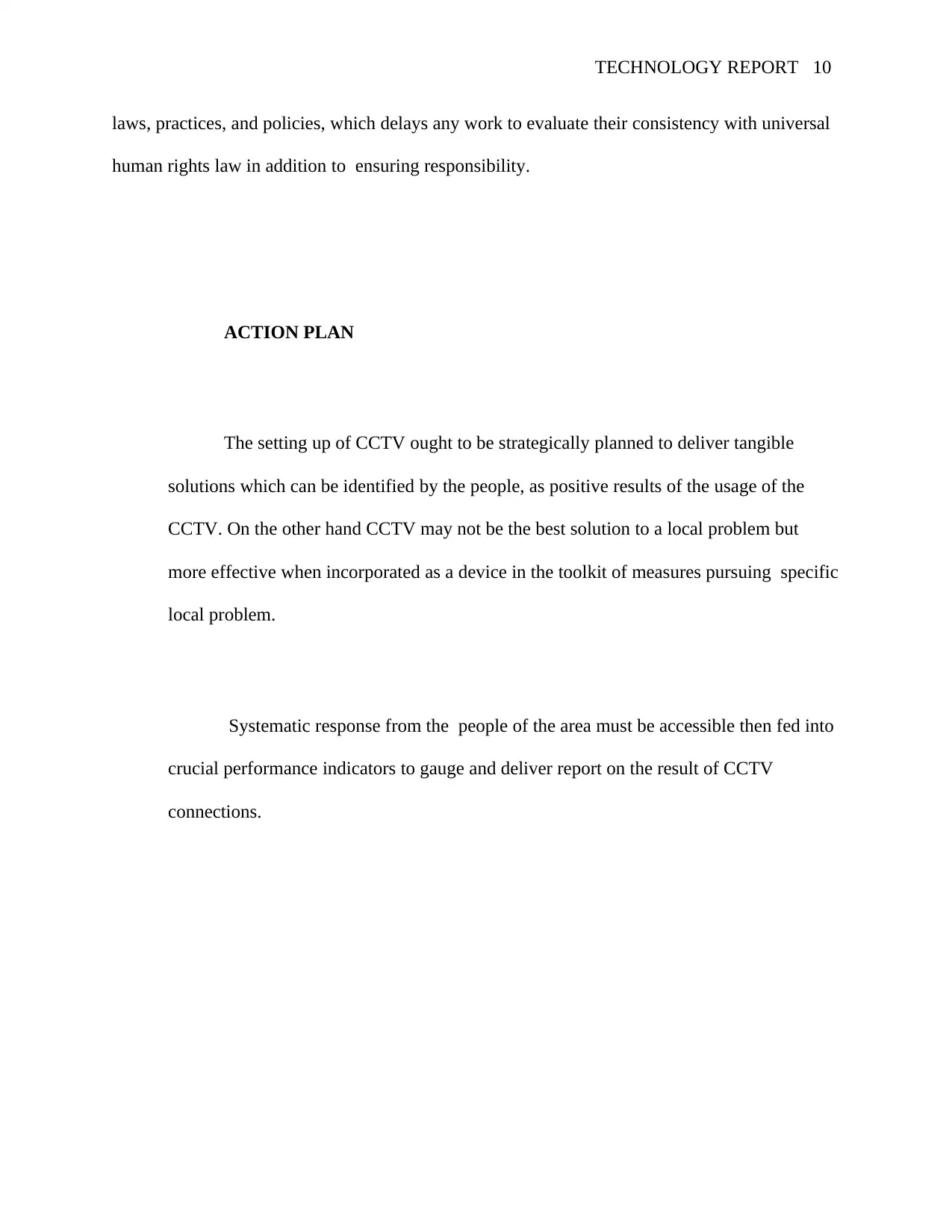
TECHNOLOGY REPORT 10
laws, practices, and policies, which delays any work to evaluate their consistency with universal
human rights law in addition to ensuring responsibility.
ACTION PLAN
The setting up of CCTV ought to be strategically planned to deliver tangible
solutions which can be identified by the people, as positive results of the usage of the
CCTV. On the other hand CCTV may not be the best solution to a local problem but
more effective when incorporated as a device in the toolkit of measures pursuing specific
local problem.
Systematic response from the people of the area must be accessible then fed into
crucial performance indicators to gauge and deliver report on the result of CCTV
connections.
laws, practices, and policies, which delays any work to evaluate their consistency with universal
human rights law in addition to ensuring responsibility.
ACTION PLAN
The setting up of CCTV ought to be strategically planned to deliver tangible
solutions which can be identified by the people, as positive results of the usage of the
CCTV. On the other hand CCTV may not be the best solution to a local problem but
more effective when incorporated as a device in the toolkit of measures pursuing specific
local problem.
Systematic response from the people of the area must be accessible then fed into
crucial performance indicators to gauge and deliver report on the result of CCTV
connections.
Paraphrase This Document
Need a fresh take? Get an instant paraphrase of this document with our AI Paraphraser
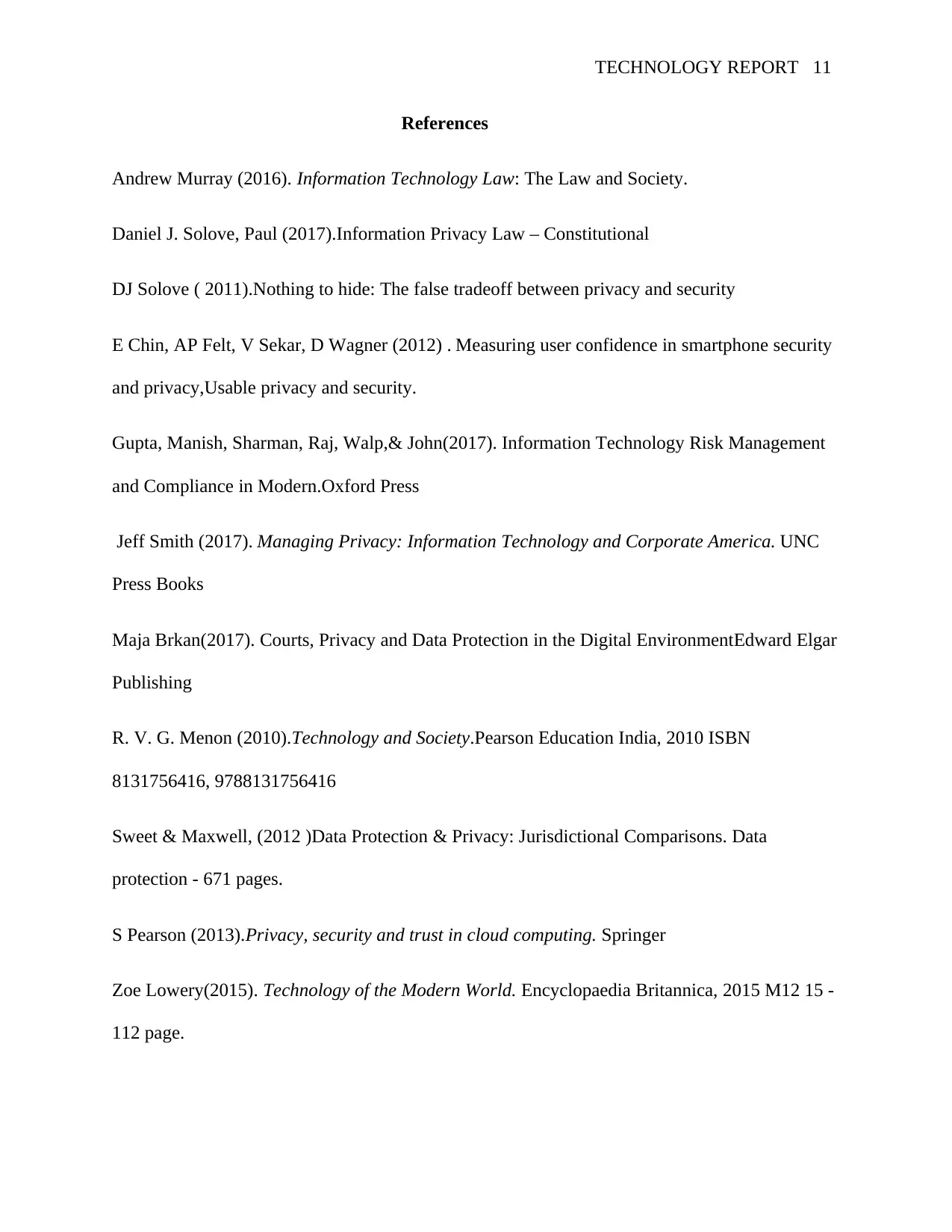
TECHNOLOGY REPORT 11
References
Andrew Murray (2016). Information Technology Law: The Law and Society.
Daniel J. Solove, Paul (2017).Information Privacy Law – Constitutional
DJ Solove ( 2011).Nothing to hide: The false tradeoff between privacy and security
E Chin, AP Felt, V Sekar, D Wagner (2012) . Measuring user confidence in smartphone security
and privacy,Usable privacy and security.
Gupta, Manish, Sharman, Raj, Walp,& John(2017). Information Technology Risk Management
and Compliance in Modern.Oxford Press
Jeff Smith (2017). Managing Privacy: Information Technology and Corporate America. UNC
Press Books
Maja Brkan(2017). Courts, Privacy and Data Protection in the Digital EnvironmentEdward Elgar
Publishing
R. V. G. Menon (2010).Technology and Society.Pearson Education India, 2010 ISBN
8131756416, 9788131756416
Sweet & Maxwell, (2012 )Data Protection & Privacy: Jurisdictional Comparisons. Data
protection - 671 pages.
S Pearson (2013).Privacy, security and trust in cloud computing. Springer
Zoe Lowery(2015). Technology of the Modern World. Encyclopaedia Britannica, 2015 M12 15 -
112 page.
References
Andrew Murray (2016). Information Technology Law: The Law and Society.
Daniel J. Solove, Paul (2017).Information Privacy Law – Constitutional
DJ Solove ( 2011).Nothing to hide: The false tradeoff between privacy and security
E Chin, AP Felt, V Sekar, D Wagner (2012) . Measuring user confidence in smartphone security
and privacy,Usable privacy and security.
Gupta, Manish, Sharman, Raj, Walp,& John(2017). Information Technology Risk Management
and Compliance in Modern.Oxford Press
Jeff Smith (2017). Managing Privacy: Information Technology and Corporate America. UNC
Press Books
Maja Brkan(2017). Courts, Privacy and Data Protection in the Digital EnvironmentEdward Elgar
Publishing
R. V. G. Menon (2010).Technology and Society.Pearson Education India, 2010 ISBN
8131756416, 9788131756416
Sweet & Maxwell, (2012 )Data Protection & Privacy: Jurisdictional Comparisons. Data
protection - 671 pages.
S Pearson (2013).Privacy, security and trust in cloud computing. Springer
Zoe Lowery(2015). Technology of the Modern World. Encyclopaedia Britannica, 2015 M12 15 -
112 page.
1 out of 11
Your All-in-One AI-Powered Toolkit for Academic Success.
+13062052269
info@desklib.com
Available 24*7 on WhatsApp / Email
![[object Object]](/_next/static/media/star-bottom.7253800d.svg)
Unlock your academic potential
Copyright © 2020–2025 A2Z Services. All Rights Reserved. Developed and managed by ZUCOL.